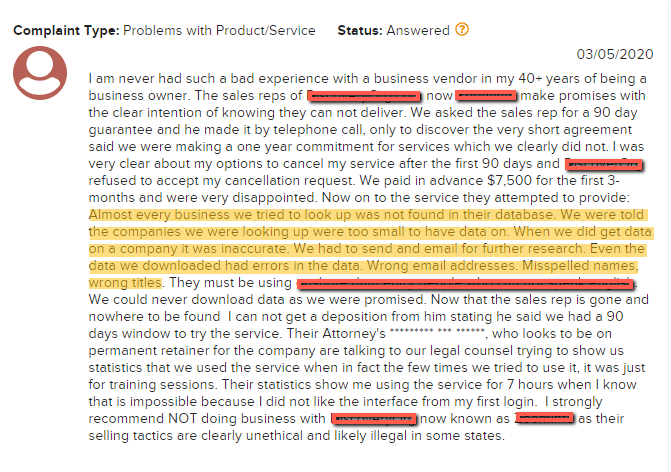B2B databases are one of the most valuable and crucial assets for your business. Unfortunately, any database – built it or buy it – doesn’t have a long shelf-life. The data changes and becomes outdated every 12-13 months for different reasons such as a job change, promotion, etc.
Reliable B2B data is considered as the foundation of your outreach campaigns. Having a list of accurate data is a real challenge as there are many problems that can be associated with B2B data such as; data completeness, reliability, consistency, timeliness, relevancy, redundancy, etc. If your sales reps are using data that’s not gone through a systematic verification process, then it is potentially wasting 27.3% of your sales reps’ time.
Why is Data Verification Important?
The core purpose of data verification is to make sure that the data you have is accurate and reliable. No data provider can provide 100% accuracy. Thus, it’s important to consider the data partner who can offer data that’s accurate and reliable to maximize the productivity of your sales reps.
We’ve discussed earlier how bad data quality hurts and costs a business. On the one hand, outdated or erroneous data can cost a business an average of $9.7 million per year.

On the other hand, verified data can increase your bottom line by providing the following benefits:
- A shorter sales cycle that can significantly reduce the time spent on prospecting.
- Better segmentation of your prospects to execute multi-level marketing campaigns.
- Minimize the time and resources spent on chasing the unqualified prospects.
- Increased ROI.
- Improved sales and marketing productivity and morale.
How is Raw B2B Data Collected?
There is no definite answer to this question as the right answer would be – from various sources. Raw data collection is mainly performed by web scrapers, that gathers vast volumes of data by often reaching through tens of millions of contacts. They operate on predetermined algorithms and sorting methods to capture all that fits the sequence. While this serves as quantity, it lacks quality such as empty spaces, incomplete data, duplicate data, inconsistent format, and several other problems.
Using this type of data for your business would leave a majority of your emails undelivered. And your sales team would spend most of their time calling numbers that don’t exist or contact the wrong person. As has been said, if data is the new oil, it is only pumping crude from the ground – valuable but useless without filtering it out.
Data Verification – Machine Processed Vs Human-Verified
There are two major data verification processes of data collection – machine processed and human-verified.
What is Machine-Processed Data?
Machine-processed data is collected (and verified) using a machine learning algorithm. Machine-processed data is gathered in huge quantities. However, no one has any idea whether the data is reliable, or even in the right format. We would say that, from a business point of view, if you are trusting data that you have not checked, then you should not trust any decisions that are taken on that basis.
What is Human-Verified Data?
Human-verified, as the name suggests, is data that’s verified by the humans. The volume of the human-verified data is often comparatively less than the machine-processed data. However, you can mostly trust the accuracy of the human-verified data.
Let us compare and contrast machine-processed data vs. human-verified data.
1. Data Quality
Machine-processed data rely on the machine-learning program that identifies the pattern of the email format and then creates other email addresses based on the pattern. This process lacks the re-verification of whether the email address exists or not. As a result, there are significant gaps in data quality. So, your marketers and sales reps may end up trying to approach a company or using an email that does not exist.
For example, one of the largest data providers in the market who recently went public, mostly relies on machine-processed data. As a result, some of their users will have an issue with inaccuracy, inconsistency, and outdated data. However the moment they face an issue with the data accuracy, they find themselves potentially helpless due to their contract obligations.
Human-verified data, on the other hand, can give you greater accuracy compared to the machine-processed data. This is because the raw data collected goes through a human-verification where a human reaches out to the person to check if the data is correct or not. This additional layer of verification makes human-verified data more accurate than the machine-processed data.
At SalesIntel, our researchers go through each data entry, correct for any mistakes, and verify the information accuracy.Through this process, you get 95% data accuracy to support your sales and marketing activities.
Winner: Human-Verified
2. Reliability
Since there are gaps in the data quality and no cross-verification or human interaction involved, machine-processed data is less reliable. Thus, relying on machine-processed data for sales forecasting or marketing campaigns might not be the best thing to do.
Whereas and as stated earlier, human-verified data is much more reliable as there’s human verification involved in the process. You can mainly trust human-verified data for sales forecasting and for making the most of your marketing campaigns.
Winner: Human-Verified
3. Scalability
The scalability is higher in machine-processed data as it’s processed by automated machines. Based on the algorithm, a machine can process millions of data in less time. So, if you are less concerned about the quality and want to reach as many people as possible, machine-processed data is a good option.
Because human-verified data is based on the human verification processes, it is not possible to match the scalability of machine-processed data. However, when it comes to scalability with accurate data, human-verified data is a clear winner.
SalesIntel has over 5M human-verified data. So how did we get 5M+ contacts verified via such a detailed and slow process? Well, we have a team of 150+ researchers!
Winner: Machine-Processed
4. Productivity
Machine-processed data without verification can kill the productivity of your sales and marketing teams. They may end up chasing the wrong prospects and leads. Additionally, every bad contact can impact the morale of your sales reps making them less interested in the data.
Also, sales reps using human-verified data are 7x more likely to connect with the decision-makers. Accurate data ensures that your team is chasing the right leads. This saves their time, boosts the sales process, helps them to achieve their goals, and keeps them motivated.
Winner: Human-Verified
5. ROI
If your ROI criteria is based on the number of contacts you get in a proposed cost, machine-processed data is a good option to choose from. However, inaccurate data can cost your company in the form of unachieved targets, lower productivity, and low morale. Thus, in terms of revenue or conversions, relying on machine-processed data is not going to give you results.
Since human-verified data is more accurate than the machine-processed data, you are more likely to reach the right prospects. It gives you a better dial-to-connect ratio, opening up more opportunities to engage the decision-makers, and increasing the conversion ratio.
With over 5M+ human-verified data contact as well as access to more data compared to the largest data provider in the industry…SalesIntel has delivered the best returns on the investment to our client.
Winner: Human-Verified
Wrapping Up
Simply put, the data is used to provide you valuable insights. Businesses empowered with this are in a position to strengthen their decision-making. With machine-processed data, the data quality level is weak, and there can be a lack of reliable insights. As a result, you might end up making poor decisions. This is why quality is more critical than quantity.
Many data providers promote their platforms claiming they offer the largest database. However, focusing too much on the data quantity, especially when that data is machine-processed, can hurt your bottom line, and ultimately your business growth. So, choose your data partner wisely.








